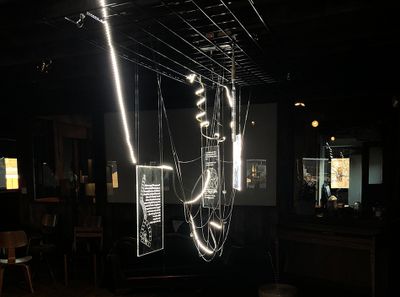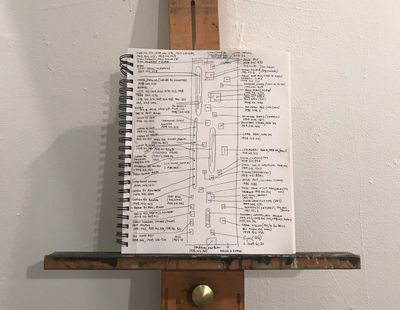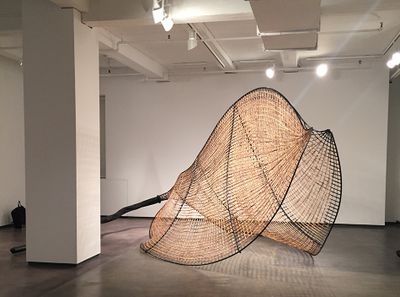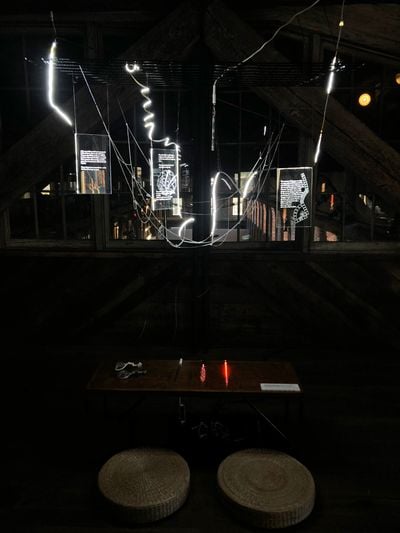Asia Contemporary Art Week: Diary #7: 29 October–11 November 2018
In collaboration with Asia Contemporary Art Week
Culling together artistic and curatorial practices from across Asia, a continent of plural histories and multiple fictions, is no easy task. Especially when that continent has also spawned worldwide diasporas comprising multivalent, transnational artists continually crisscrossing spatial and temporal borders. The effectiveness of Asia Contemporary Art Week is that it continues to assert 'Asia' and 'Asian' as a loose conglomerate of relational strategies, rather than as fixed notions of place and identity. The final three weeks of the programme saw three further Open Studios events of diverse artists practicing across a spectrum of mediated environments; a politically charged exhibition of printed matter spotlighting the history of Anti-Asian racism in the United States; and a solo exhibition of tactile sculptures and works on paper by a critically-renowned artist from Cambodia.

Xin Liu, 'Thinking Collections: Open Studios', Artist Studio, Pioneer Works, Brooklyn, New York (11 November 2018). Courtesy Asia Contemporary Art Week.
Vikram Divecha, a graduate student currently enrolled in Columbia University's MFA programme, started off the week on 29 October with an Open Studio. Divecha's two studio spaces are housed in Prentis Hall in West Harlem, just across the street from the brand new Manhattanville campus, which looks like an interstellar spaceship just landed (it was designed by Renzo Piano). Divecha was already talking about his project, Train to Rouen (2017), when I arrived. Taking Claude Monet's painting The Gare Saint-Lazare (1877) which is displayed at the Louvre Abu Dhabi as his point of departure and inspiration, Divecha delayed a train (with the support of SNCF, the French National Railway Corporation) by five minutes, from Paris to Rouen, leaving from Gare Saint-Lazare. He then obtained a 'traffic occupation chart' from the railway—a graphic score that indicates the waiting times of trains on the station's platforms—to show how this induced alteration had impacted the entire train schedule for that day. A video piece documenting the delayed train, along with charts, and photographs of a complex, multi-gridded installation that was devised from the records and commissioned by the Department of Culture and Tourism Abu Dhabi and institut français, were all on display. The installation was previously exhibited at the Louvre Abu Dhabi as part of the group show, Co-Lab: Contemporary Art and Savoir-faire (21 December 2017–26 August 2018). By introducing systemic glitches, Divecha frames dialogic questions about the structural value of time, material, and labour in capitalist systems in this, and other projects he talked about, including Beej (Seed [in Urdu]) (2017). For Beej, the artist commissioned migrant labour in Sharjah, United Arab Emirates to plant a garden in a residential roundabout using seeds from their family farms in Lahore and Punjab. These works subversively underscore inequities in systems and reveal how a minor ripple has the potential to produce transformational shifts. A hopeful metaphor perhaps, for the artist and society.
On Thursday, 1 November, Tyler Rollins Fine Art opened Expanses, a solo exhibition by Cambodian artist Sopheap Pich (1 November–21 December 2018). The gallery's tenth floor space in Chelsea is sparsely populated with earthen-toned sculptures and works on paper that together produce an impression of suspended time. Three floor-standing sculptures, titled Ordeal (2018), Monument 1 (2015) and Monument 2 (2016), combine organic and geometric elements with locally sourced materials and pristine craftmanship. The paradox of unity and dissonance is a subtle thread that ties these quiet, but potent, works together. Ordeal, the largest and most poignant work, takes its name from the seed pods of a tree whose powdered bark is a medicine that at high doses, the press release informs, becomes poisonous. The monumental sculpture, made primarily of bamboo and wood, with its serpentine tail and fanned, rearing hood resembles a cobra, striking an ominous chord despite its physical beauty. The dense, carved, patterned and solid materiality of the sarcophagus-like structures, Monument 1 and Monument 2, belie their sense of impermanence, so that these sculptures appear to both mark space while being embalmed within it. Pich, who studied art in America at The University of Massachusetts and The School of the Art Institute of Chicago before returning to his native roots, has been deeply impacted, like most Cambodians, by the country's bloodied history. His elegant works simultaneously evoke the past and futurity, memory and possibility, trauma and the potential for healing.
The next evening, on Friday 2 November, two events opened across two cities: New York and Philadelphia. Artist and composer, Satya Hinduja, presented her second Open Studio, but this time, in Dumbo, Brooklyn. Hinduja, who studied at Berklee College of Music, probes the relationship between music and medicine; using sound, neuroscience, and technology to foster multivalent regenerative experiences. I removed my footwear and was given a pair of hi-tech headphones playing synthesised sound. Once inside the dimly lit studio, I encountered an environment which recalls a meditation portal. The press release instructs: 'As you enter the space, please acknowledge your breath and its speed.' The delicate scent of incense burning gently in a corner accompanied black and white drawings by Hinduja in ink and charcoal, lightboxes with more essentialist drawings stacked like a pyramid, and a giant blackboard that invited participants in the soundscape to draw freely—which many did, using large sticks of coloured chalk. Doodles of mystical signs, symbols, and deities appeared on the board, adding a playful and performative aspect to the Open Studio.
At the same time in Philadelphia, Twelve Gates Arts opened an exhibition called American Peril: Imagining the Foreign Threat (2–30 November 2018). By connecting four distinct periods–the Chinese Exclusion Era in the mid-1800s, WWII Anti-Japanese Propaganda, the Auto Industry's Japan Bashing in the 1970s and 1980s, and Post-9/11 Islamophobia—the exhibition examines the fragile existence of minority communities, and how opportunely they are turned into targets for national hatemongering. On display are a series of more than 60 printed works curated by Rob Buscher and Jamal J. Elias, which dovetails an exhibition at the gallery last year, I Bear Witness (2017) about anti-Muslim bias in the current political climate. The objects, which range from stamps, playing cards, Halloween masks, promotional posters, advertising images to popular books, unveil the relationship between contemporary political rhetoric of a perceived foreign threat, and the production of propaganda of an imagined enemy. 'By framing highly amplified contemporary issues such as Islamophobia as part of the larger historic trend, the show encourages viewers to consider historical precedents and their effects, and to think more critically about today's (21st century) xenophobia', the press release states. Around 200 people attended the opening, and the most common response, according to the gallery's director, Aisha Zia Khan, was one of amazement at how persistent and historically prevalent Anti-Asian and Anti-Muslim contempt and intolerance has been in mainstream America.
To round off the season, Xin Liu, who is currently an artist-in-residence at the Queens Museum, presented an on-going project on the fantastical journey of her wisdom teeth being sent to space, at Pioneer Works, Brooklyn on Sunday, 11 November. Xin Liu, an artist and engineer from Xinjiang, China who studied at MIT Media Lab, has a research-oriented practice that includes performance, apparatus, installations, and scientific experiments to examine the empathic potential of technology on human experience. According to the artist's note, the teeth become stars at the end of their lives and 'unmake alienated technological space programs' to reimagine more active and empathic forms of engagement. A hanging installation made of aluminum, 3D prints, magnets, nylon string, motors and electronics produced an otherworldly effect, and provided a focal gathering point for Xin Liu's enquiry into space and empathy.
Being a participant in the 13th edition of this platform as an artist, facilitator and writer, I witnessed a complex, energetic vision of worlds in formation. Asia Contemporary Art Week did not attempt to offer a view of what art is–that's up to museums and biennials to do–but offered instead, a framework to think about what art can do. It would be gratuitous of me to even attempt to connect the dots between entirely dissimilar disciplines. But, if I am to point to common denominators that emerged from the week, I would underscore trauma and technology as agents for connection and deep healing. At a time when the very notion of democracy is at stake in a burgeoning national climate of divisiveness and fear, Asia Contemporary Art Week did just that: it created a democratic forum in which artists, curators and producers working at varied registers and moments within their careers could participate in a larger process of self-determination. More importantly, it provided a constructive dialogic space in which we could gather together, and share. Given this fraught, contentious and messy political moment, forming new friendships within our communities may be the most radical thing we can do. —[O]










































































































































































